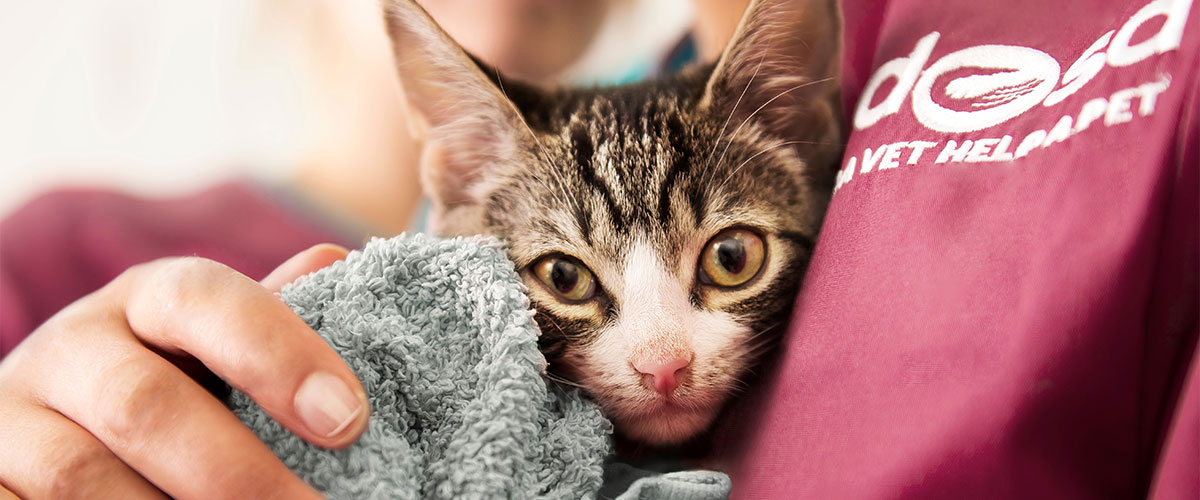Snake bites in cats
Overview
- Snake bites are much rarer in cats than they are in dogs, but if you think your cat might have been bitten, follow our first aid advice and take them to a vet ASAP.
- There are three types on snake found in the UK, but adders are the only venomous species.
- Adder bites tend to happen Feb-Oct but are especially common between Jun-Aug.
- With treatment, most cats recover from adder bites, but some can be very serious, cause severe illness and even death.
General Information
There are three types of snake in the UK: grass snakes, smooth snakes and adders. The adder is the only venomous species, grass snakes and smooth snakes aren’t venomous and don’t tend to bite.
Fortunately, adders tend to keep themselves to themselves and don’t bite unless they are scared.
If your cat has bitten by an adder, their symptoms will depend on where the bite is, and where the venom spreads to. If the venom stays in the tissues around the bite, it will cause pain and swelling, but if it spreads further and gets into the bloodstream, it can cause much more serious problems such as damage to the liver, kidneys, heart and nervous system. If venom is injected straight into the blood stream, it can cause death very quickly. It can also be very serious if your cat is bitten on the face, tongue or neck because swelling can lead to breathing problems.
With treatment, most cats make a full recovery, but sadly, in some cases, adder venom can cause severe illness and even death. The quicker your cat is treated, the better their outlook. Any cat with a suspected adder bite should be seen by a vet ASAP.
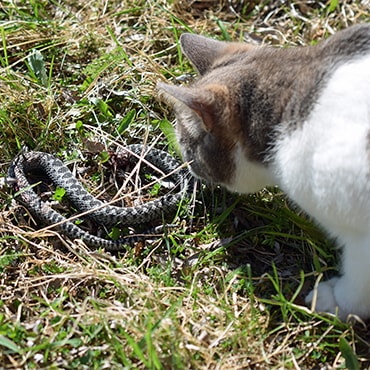
First aid for a snake bite
- Stay calm
- If you see the snake, try to remember what it looks like, or take a photo from a distance. Do not try to find the snake, get close to it, touch it or harm it. (Adders are a protected species so it is illegal to hurt or kill them, and they can bite people if disturbed)
- Keep your cat as still as possible to prevent venom spreading around their body
- Leave the bite alone, don't apply a bandage or tourniquet
- Call your vet to let them know you are coming down to the practice.
What do adders look like?
Adders are easy to identify (see image below), they are small, grey/brown snakes with a distinctive V-shaped marking on their head and dark zigzag pattern down their back.
They are most common in long grass, woodland, moorland and by the coast (sand dunes/coastal paths). They are active Feb-Oct and hibernate during the winter.
The adder
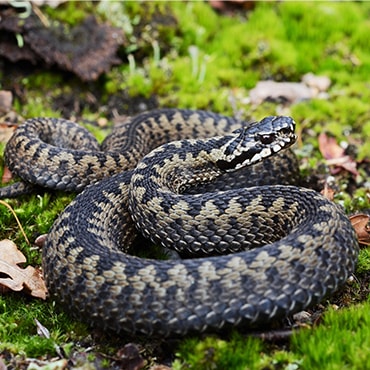
The adder is a small, chunky snake with an obvious zig-zag pattern down its back and a V-shape marking on its head.
Grass snake
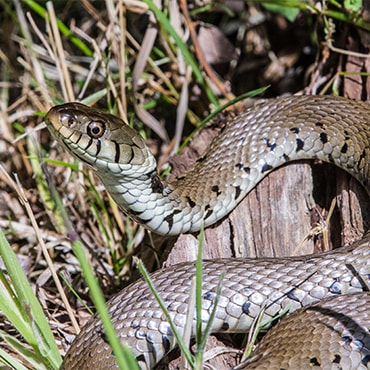
The grass snake is a green/brown snake with yellow and black markings behind its head and dark patterning down it's sides.
Smooth snake
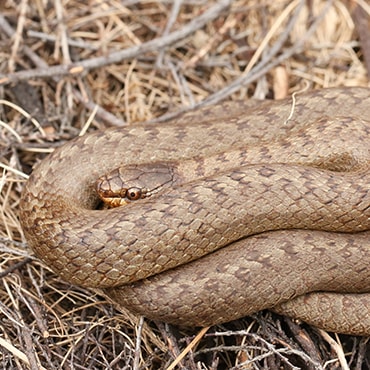
The smooth snake is very rare, looks similar to an adder but its slimmer and doesn't have the obvious zig-zag pattern down its back. Smooth snakes vary from being grey to dark brown.
Symptoms
Adder bite symptoms can take anywhere between couple of minutes to an hour to develop. They tend to be worse in cats that are bitten on the face or neck, and much worse if the venom makes its way into the blood stream instead of staying around the bite.
Mild symptoms:
- Pain and swelling around the bite
- Limping (if bitten on a leg)
- A few tiny bite marks
Serious symptoms:
Very severe and potentially life threatening symptoms:
- Weakness and wobbling
- Swelling to the face or neck
- Severe bruising and abnormal bleeding
- Tremors and seizures
- Difficulty breathing
- Collapse
- Sudden or unexplained death can occur if adder venom is injected straight into the blood stream.
Treatment
If your cat has been bitten by a snake, it’s important they are seen by a vet ASAP, don’t attempt to treat them at home. Treatment will depend on the symptoms they develop, but as a start, is likely to involve:
- Strong pain relief
- Careful monitoring - your vet will monitor your cat closely and keep an eye out for complications such as kidney failure, heart problems and bleeding problems. It’s likely that your cat will need to stay in for monitoring and investigations (for example ECG’s or blood tests) for at least 24 hours unless they only have very mild symptoms.
- A fluid drip - to support their internal organs (such as the liver, kidneys and heart), and help them if they have gone into shock.
- Antihistamines - to help reduce swelling and further symptoms developing.
In more serious cases, your cat might require:
- Anti-venom - not all cats need anti-venom but it’s sometimes necessary in more severe cases. It’s important to know that there is a small risk of a drug reaction when using anti-venom, and it can be very difficult to get hold of.
- Antibiotics - only necessary if your cat develops an infection around their bite wound
- Surgery - some cats develop necrosis (tissue death) around the bite wound. If your cat develops necrosis, they may need an operation to remove the dead tissue.
When to contact your vet
Snake bites should always be treated as an emergency - if your cat has been bitten, follow our first aid advice and call you vet straight away. Do not attempt to treat your cat at home.
Cost
Treating an adder bite can be very expensive, especially if your cat needs intensive care in a veterinary hospital. It’s important to speak openly to your vet about your finances, the cost of treatment, as well as what you think is right for your cat.
When you welcome a new cat into your life, consider getting Cat Insurance straight away before any signs of illness start. This will give you peace of mind that you have some financial support if they ever get sick.
Published: July 2020
Did you find this page useful?
Tell us more
Please note, our vets and nurses are unable to respond to questions via this form. If you are concerned about your pet’s health, please contact your vet directly.
Thank you for your feedback
Want to hear more about PDSA and get pet care tips from our vet experts?
Sign up to our e-newsletter
Written by vets and vet nurses. This advice is for UK pets only. Illustrations by Samantha Elmhurst.

